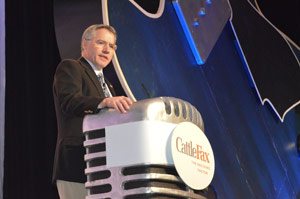The Business Has Changed;
Be Prepared
by Kindra Gordon for Angus Productions Inc.
NASHVILLE, Tenn. (Nov. 3, 2012) — “It’s a great time to be in ag, but you must adapt to a global market environment,” CattleFax’s Randy Blach told Cattle Industry Convention attendees Feb. 3 in Nashville, Tenn. The Annual CattleFax Outlook Seminar highlighted the market factors that are setting the stage for beef supply and demand and prices in 2012 and beyond.
Blach underscored how much the cattle business — and the global population — have been changing in the last few decades. Despite decreasing per capita beef consumption domestically, he noted that U.S. beef exports have been setting records for growth and helping fuel global beef demand and the current high market prices for beef cattle.

Randy Blach Photo by Kasey Miller
He pointed to the statistic that by the year 2050, the world’s population will be 9 billion people, and asked, “Who’s going to feed them?”
Referring to this population growth, Blach stated, “You see the opportunity. We’re going to have to get better and have more productivity.”
Blach stated, “This is not a short-term phenomenon. If you think it will be less of a global market in the future, you’re sorely mistaken. It’s a different business. It doesn’t look anything like it did 10 years ago, and in five years it won’t look anything like it does today.”
Looking ahead, Blach made the following points that will be crucial to the U.S. beef industry:
-
We have to continue to grow international markets for U.S. beef and have access.
-
We have to get used to higher costs all the way through the system.
-
We have to adjust to volatile markets.
Blach said, “All markets are more global in nature. As trade grows, market participants around the globe will rely on futures and options markets to manage risk. We need viable risk-management tools.”
He re-emphasized that it’s not the same business it was 10 years ago, and pointed out that weekly price changes can be as much as $50 per head when the volatility in cattle and corn markets is combined. As well, he reported, it takes 60% more capital to operate in 2012 than in 2009.
“Things have changed greatly. You can’t put all your eggs in the spot market due to volatility,” he said to cattle producers and feeders. Already, he shared, 65% of beef is selling in different avenues than the spot market due to the volatility.
While managing volatility is a challenge, Blach said he anticipates the price outlook to be favorable for the beef industry. Feeder price projections for the year ahead are in the $157-$161 per hundredweight (cwt.) range. Fed cattle are anticipated to be $130-$134 per cwt.
Regarding the high market, Blach said, “Will a $200- to $400-per-head profit incentive be enough to start expansion? Is this economic signal going to be strong enough? Yes, we will grow this herd in the next several years. Don’t second-guess the market.”
But he also cautioned: “Don’t get caught in the euphoria. These are dangerous times. These markets all have corrections, and this one is no different. Be mindful of the risks at hand.”
“I encourage you to become more of a risk manager. Make that leap. We (CattleFax) can help. Manage for a margin; don’t guess the markets,” he concluded.
-----------------------------
Editor’s Note: The above article was written under contract or by staff of Angus Productions Inc. (API). It may not be reprinted without express permission of API. To request reprint permision, contact the editor at 816-383-5200.
www.4cattlemen.com is an event coverage site provided by the editorial team at Angus Productions Inc. (API), publisher of the Angus Journal, the Angus Beef Bulletin, the Angus Beef Bulletin EXTRA and the Angus e-List. For questions about this site, to submit an article for our consideration, or to report a broken link, contact the editor at 816-383-5200; 3201 Frederick Ave., Saint Joseph, MO 64506.
API claims copyright to this web site as presented. We welcome educational venues and cattlemen to link to this site as a service to their audience.

